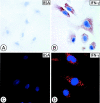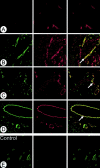Guanylate-binding protein-1 expression is selectively induced by inflammatory cytokines and is an activation marker of endothelial cells during inflammatory diseases
- PMID: 12414522
- PMCID: PMC1850787
- DOI: 10.1016/S0002-9440(10)64452-5
Guanylate-binding protein-1 expression is selectively induced by inflammatory cytokines and is an activation marker of endothelial cells during inflammatory diseases
Abstract
During angiogenesis and inflammatory processes, endothelial cells acquire different activation phenotypes, whose identification may help in understanding the complex network of angiogenic and inflammatory interactions in vivo. To this goal we investigated the expression of the human guanylate-binding protein (GBP)-1 that is highly induced by inflammatory cytokines (ICs) and, therefore, may characterize IC-activated cells. Using a new rat monoclonal antibody raised against GBP-1, we show that GBP-1 is a cytoplasmic protein and that its expression in endothelial cells is selectively induced by interferon-gamma, interleukin-1alpha, interleukin-1beta, or tumor necrosis factor-alpha, but not by other cytokines, chemokines, or growth factors. Moreover, we found that GBP-1 expression is highly associated with vascular endothelial cells as confirmed by the simultaneous detection of GBP-1 and the endothelial cell-associated marker CD31 in a broad range of human tissues. Notably, GBP-1 expression was undetectable in the skin, but it was highly induced in vessels of skin diseases with a high-inflammatory component including psoriasis, adverse drug reactions, and Kaposi's sarcoma. These results indicate that GBP-1 is a novel cellular activation marker that characterizes the IC-activated phenotype of endothelial cells.
Figures





Similar articles
-
Nuclear factor-kappaB motif and interferon-alpha-stimulated response element co-operate in the activation of guanylate-binding protein-1 expression by inflammatory cytokines in endothelial cells.Biochem J. 2004 Apr 15;379(Pt 2):409-20. doi: 10.1042/BJ20031873. Biochem J. 2004. PMID: 14741045 Free PMC article.
-
The helical domain of GBP-1 mediates the inhibition of endothelial cell proliferation by inflammatory cytokines.EMBO J. 2001 Oct 15;20(20):5568-77. doi: 10.1093/emboj/20.20.5568. EMBO J. 2001. PMID: 11598000 Free PMC article.
-
Inflammatory cytokines induce endothelial cells to produce and release basic fibroblast growth factor and to promote Kaposi's sarcoma-like lesions in nude mice.J Immunol. 1997 Feb 15;158(4):1887-94. J Immunol. 1997. PMID: 9029130
-
Human guanylate binding protein-1 (hGBP-1) characterizes and establishes a non-angiogenic endothelial cell activation phenotype in inflammatory diseases.Adv Enzyme Regul. 2005;45:215-27. doi: 10.1016/j.advenzreg.2005.02.011. Epub 2005 Jul 6. Adv Enzyme Regul. 2005. PMID: 16005050 Review.
-
Pathophysiological role of guanylate-binding proteins in gastrointestinal diseases.World J Gastroenterol. 2016 Jul 28;22(28):6434-43. doi: 10.3748/wjg.v22.i28.6434. World J Gastroenterol. 2016. PMID: 27605879 Free PMC article. Review.
Cited by
-
The guanylate binding protein-1 GTPase controls the invasive and angiogenic capability of endothelial cells through inhibition of MMP-1 expression.EMBO J. 2003 Aug 1;22(15):3772-82. doi: 10.1093/emboj/cdg382. EMBO J. 2003. PMID: 12881412 Free PMC article.
-
Glycosylated protein-related microenvironmental features in breast cancer are associated with patient prognosis.Mamm Genome. 2025 May 24. doi: 10.1007/s00335-025-10137-9. Online ahead of print. Mamm Genome. 2025. PMID: 40411577
-
Guanylate-binding protein 1 participates in cellular antiviral response to dengue virus.Virol J. 2012 Nov 27;9:292. doi: 10.1186/1743-422X-9-292. Virol J. 2012. PMID: 23186538 Free PMC article.
-
Nuclear factor-kappaB motif and interferon-alpha-stimulated response element co-operate in the activation of guanylate-binding protein-1 expression by inflammatory cytokines in endothelial cells.Biochem J. 2004 Apr 15;379(Pt 2):409-20. doi: 10.1042/BJ20031873. Biochem J. 2004. PMID: 14741045 Free PMC article.
-
Common denominator genes that distinguish colorectal carcinoma from normal mucosa.Int J Colorectal Dis. 2005 Jul;20(4):353-62. doi: 10.1007/s00384-004-0664-7. Epub 2004 Dec 22. Int J Colorectal Dis. 2005. PMID: 15614505 Clinical Trial.
References
-
- Cines DB, Pollak ES, Buck CA, Loscalzo J, Zimmerman GA, McEver RP, Pober JS, Wick TM, Konkle BA, Schwartz BS, Barnathan ES, McCrae KR, Hug BA, Schmidt AM, Stern DM: Endothelial cells in physiology and in the pathophysiology of vascular disorders. Blood 1998, 91:3527-3561 - PubMed
-
- Cotran RS, Pober JS: Endothelial Activation: Its Role in Inflammatory and Immune Reactions. 1988:pp 335-347 Plenum Press, New York
-
- Roesen P, Ferber P, Tschoepe D: Macrovascular disease in diabetes: current status. Exp Clin Endocrinol Diabetes 2001, 109(Suppl):S474-S486 - PubMed
-
- Baumgartl HJ, Standl E: The atherosclerotic process and its exacerbation by diabetes. Exp Clin Endocrinol Diabetes 2001, 109(Suppl):S487-S492 - PubMed
Publication types
MeSH terms
Substances
LinkOut - more resources
Full Text Sources
Other Literature Sources
Medical
Research Materials

